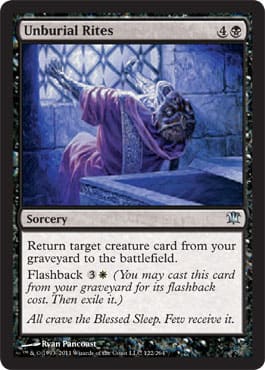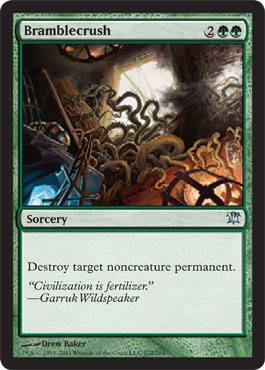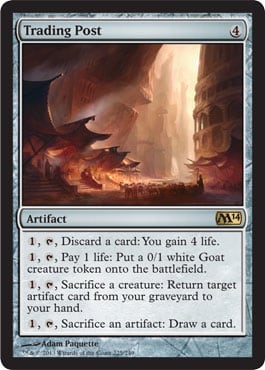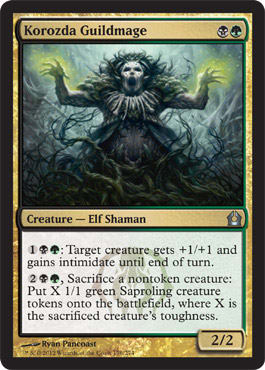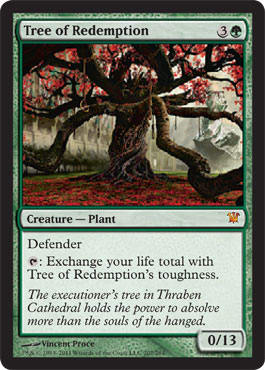As the theme week color combination, B/G ordinarily is about depth, flexibility, and resilience. Because it doesn’t have the highest raw power nor can it make a hyper-aggressive deck, it’s left to other spots of the Decktagon to make the color pair work.
Part of Decktagon theory is that certain card attributes are on opposite sides of an axis. When you can break an axis by scoring prominently on both its poles, your deck is “broken.” Tournament play ordinarily points to breaking the power–speed axis. Getting the best stuff faster than you should is familiar to us in several forms. Unburial Rites combo decks are trying to break power–speed, as are most combo decks. A fourth-turn Griselbrand is scary by any measure, and it’s clear how that wins games.
Since B/G usually has the easiest time with attacking an opponent’s board (flexibility) and has enough resilience (life-gain, recursion, creatures with death triggers) to jam into a deck, it should be the color pair most adept at breaking the flexibility–resilience axis. We’ve seen prominent decks that have broken this axis, but it’s less obvious when it happens because it doesn’t hit you in the face as power–speed does. Caw-Blade was in part about the flexibility–resilience axis—it was a tough deck to kill, chump-blocking with Squadron Hawk, offering protection from several colors via Equipment, bouncing creatures with Jace, the Mind Sculptor, and so on. Of course, that deck’s tutor package and consistent card-draw through Jace’s Brainstorm ability plus fetch lands gave the deck a numbing consistency as well, but it also managed to break the axis in question.
My goal today is to articulate principles of breaking the flexibility–resilience axis. It should produce some winning decks without being traditionally oppressive. Besides, flexibility and resilience are valued more in multiplayer than in duels, so solving this puzzle puts us on a casual track anyway.
What Are We Looking For?
Flexibility is about attacking an opponent’s board—getting rid of his stuff. This is a straightforward category. Black excels at flexibility against creatures (Doom Blade and Black Sun's Zenith) while green’s great at the rest (Bramblecrush and friends). Resilience is about staying alive and preserving your board—gaining life, some forms of rattlesnake, hexproof creatures, and so on. Black and green are good here, too. White’s often better for pure life-gain, but black and green both gain life attached to things you were doing already. As the primary colors of deathtouch and regeneration, there’s plenty of resilience through nasty blockers. Green brings hexproof and shroud to the party, and both creatures bring glorious death triggers and this lovely spinach dip. (Party motif—got carried away. Also, I might want spinach dip.)
So, we’re in the best colors to break the axis. How about some decks highlighting how to break it?
Trading Post
I’ve built with Trading Post in this column, and there was an awesome Post deck in Standard that was also loads of fun. It centered around Trading Post and Wurmcoil Engine, a flexibility–resilience master by itself (almost anything with lifelink and deathtouch will be), using Wellsprings as the consistency to get there. Trading Post can gain life and provide chump-blockers while serving as a source of eventual recursion, so it’s promising flexibility and resilience as well. Moving out of Standard, we should be able to find ways to make Trading Post even sillier than it already is.
This is what I’ve come up with:
"Golgari Trading Post"
- Creatures (19)
- 4 Painsmith
- 3 Wurmcoil Engine
- 4 Glaze Fiend
- 4 Salvage Slasher
- 4 Glissa, the Traitor
- Spells (18)
- 3 Mycosynth Wellspring
- 3 Skyshaper
- 4 Executioner's Capsule
- 4 Ichor Wellspring
- 4 Trading Post
- Lands (23)
- 8 Forest
- 9 Swamp
- 2 Buried Ruin
- 4 Golgari Guildgate
Hey, look; it’s a bunch of my favorite oddballs! The Standard shell is present—Wurmcoil Engine, Trading Post, and Wellsprings—but the rest gives another feel. It isn’t quite as combo-heavy, as there’s no Nihil Spellbomb to cycle through a gazillion cards, nor is there the board sweep associated with the tournament deck. In its place are:
- Glissa, the Traitor – We’re in the colors, so why not? I went with Executioner's Capsule over Perilous Myr since it’s cheaper and always kills a creature and because I’ve built so many decks with Glissa/Myr that I wanted to do it differently.
- Glaze Fiend – The deck has enough cheap artifacts that I thought this might push in a load of flying damage.
- Salvage Slasher – A favorite of mine in artifact combo decks, the front end is ridiculous after enough time. Presumably, if you recur a 10/1 Slasher, it’s a good thing. It’s sort of a backup Executioner's Capsule in that way.
- Painsmith – I’ve never used this, and I’ve wanted to. It seems very good with Glaze Fiend, and on some boards, it will sneak a Salvage Slasher through that otherwise wouldn’t make it.
- Skyshaper – This is one of those cards that you forget was made until it shows up and owns some faces. It’s probably obvious this is best in a green deck, where you have big things that want evasion, but here, it serves a few purposes. You have no problem ditching it to Trading Post when you don’t need it, and later, it will turn Salvage Slashers and Wurmcoil Engines into flying machines.
Trading Post already had the resilience end covered, and Glissa’s first strike and deathtouch puts her on both ends of the flexibility–resilience axis, but I’ve upped the ways to deal damage. I hope this deck also plays faster than the Standard deck, which sat around and cycled longer than I normally like.
This version has a lot more options to fit your collection than the W/B/R Standard deck did. That deck needed Ratchet Bomb, Day of Judgment, and Slagstorm to make sense. Here, you could substitute a lot of things in my version and end up with the same idea. Everything from Disciple of the Vault to Chimeric Egg could go in if you wanted. There are many variations on this theme.
Saproling Chain
"Korozda Combo"
- Creatures (23)
- 4 Korozda Guildmage
- 4 Spawnwrithe
- 4 Thallid Shell-Dweller
- 4 Tree of Redemption
- 4 Woebringer Demon
- 3 Chainer, Dementia Master
- Spells (13)
- 2 Beast Within
- 3 Urborg Justice
- 4 Echoing Courage
- 4 Plunge into Darkness
- Lands (24)
- 11 Swamp
- 9 Forest
- 4 Golgari Guildgate
Now, I have no idea how good this deck is, but whatever it does should be exciting. Like most decks I enjoy making, this one has several overlapping interactions that turn to profit; what you draw might not be the interaction you want right then, but you’ll generate some synergy regardless.
So, how does this deck attempt to break the flexibility–resilience axis? By turning high-toughness creatures into tokens and turning those tokens into life, creature kill, and player kill. You can turn your defense into offense on an end step with some surprising instants. It’s the principles that make Attrition a good card, only souped up to silly proportions.
Korozda Guildmage is the basis for selecting most of the other cards. I have fewer things to give intimidate to than I would like—Spawnwrithe’s the biggest one—but there are several high-toughness creatures to turn into Saprolings. Thallid Shell-Dweller makes Saprolings before Korozda Guildmage turns it into more Saprolings.
Of course, the best way to make Saprolings in this deck is to sacrifice Tree of Redemption to Korozda Guildmage. But thirteen Saprolings isn’t the whole story, as Plunge into Darkness (here more for the life-gain than the card-draw) can turn previous Saprolings into life, possibly turning Tree of Redemption into more Saprolings. For example, with a Korozda Guildmage, Thallid Shell-Dweller, and Tree of Redemption, sacrifice the Shell-Dweller to the Guildmage for five Saprolings. Sacrifice those five Saprolings to Plunge into Darkness to gain 15 life. Switch your life total with Tree of Redemption’s toughness to make the Tree absurdly tough, then turn it into thirtyish Saprolings. It’s convoluted, but it saves your life and is eventually lethal in the same line of play.
Apart from a lethal Saproling or Spawnwrithe army (for which Echoing Courage exists), Woebringer Demon is the way to turn your tokens into flexibility. This deck should have no problem finding spare creatures to keep Woebringer Demon alive. As for your opponents, they’ll vary in creature count, although you can use a Beast Within on a player’s best permanent to surprise him with a creature. The Demon should be a reliable source of flying damage and creature kill, which is a nice combination.
Chainer, Dementia Master does a couple things for this deck. It sets up an effective, if expensive, loop with Korozda Guildmage for Saprolings, it enables Tree of Redemption to keep you alive for longer (besides creating a Nightmare Plant) while negating the 3 life necessary to reanimate it, it returns Woebringer Demon whenever appropriate (nice Progenitus, player to my immediate left), and it lets you reap the fruit of forcing others to sacrifice with the Demon. Finding ![]()
![]()
![]() while having mana to do other stuff is tricky, but the payoff is worth it.
while having mana to do other stuff is tricky, but the payoff is worth it.
Last but not least given the theme, Urborg Justice turns frustrated or chump-blocking Saproling armies into targeted board wipe. Should you have enough black mana, you could cast this after Plunge into Darkness on the same turn to turn the game on its ear. Since Plunge into Darkness and Urborg Justice are both cheap instants, they don’t have to synergize to be effective; either can take advantage of a sympathetic board state to get the job done.
This deck is built to be whatever strategy the situation demands. There are sudden ways to kill swaths of creatures, there are life-gain and high-toughness creatures, and there’s a load of stuff in between. It may not break the flexibility–resilience axis, but it certainly operates along it, and the deck style should demonstrate that having flexibility and resilience at the same time is very tough to beat.
What Have We Learned?
B/G can break the flexibility–resilience axis best when it turns its creatures into creature kill. Glissa/Wurmcoil Engine, Urborg Justice/Saprolings, Attrition, Ulvenwald Tracker, and a few other cards can achieve that end, and the decks are more fun (at least to me) than decks with quick, powerful combo kills. You can build B/G to be pretty broken, and focusing on creature death seems to be the way to maximize it.















